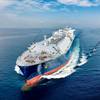By Capt. Johan Schild
In 2002 the globally operated Korean engineering and construction firm Daewoo E & C Co., Ltd., secured a project order from Shell Petroleum Development Company (SPDC) of Nigeria to construct a gas gathering plant on two concrete barges, to be positioned in the Awoba Creek near the Sambriero River. This gas gathering plant would be connected with a pipeline to the Cawthorne Channel Integrated Project (CCIP).
The CCIP is a gas-gathering project, which is a big step forward in contributing to the "flare out" target date in 2008 of the numerous gas flares, as mandated by the Nigerian Government.
On December 19 and 22, 2003, respectively, the Process Barge and the Control Barge were safely put on the underwater foundation in Awoba, and first gas is expected by Spring 2004.
These concrete barges were built in New Orleans, La., by Stolt Offshore Inc., a builder of concrete barges for the oil and gas industry. On completion of construction the barges were towed from the Stolt Offshore plant in eastern New Orleans into the Barataria Waterway to the Grand Isle Shipyard (GIS) in Lafitte, La., to be outfitted with the equipment to complete the gas gathering plant.
The Barataria Waterway, being part of the U.S. Intracoastal Waterway system, was not maintained and dredged to its original water depth, and in anticipation of overdue dredging to be done before completion of the outfitting, Grand Isle Shipyard was given the contract.
However, severe Federal budget constrains in 2003 affected the operations of the U.S. Corps of Engineers and in turn their dredging plans for deepening the Barataria Waterway channel were postponed indefinitely.
This had a catastrophic effect on the project as the Concrete barges on completion of outfitting ended up being three feet and five feet too deep to pass the shallow areas of the Barataria Waterway, which shallows were several miles long according to bathymetric surveys.
Daewoo, their freight forwarder Lysander Shipping and other marine consultants brainstormed, and various methods were considered to sufficiently lift the barges for safe passage over the shallows, including lift bags, floating cranes, lifting barges/pontoons and dredging.
There were a number of serious constraints and limits such as the bending moments and shear forces of the concrete barges in regard to the lift, time and budget constraints, size of lifting devices, keel clearances and so on.
Daewoo elected to have forward and aft lifting pontoons built with fingers to raise the barges, connected by heavy trusses to keep the structure together. This structure was also to be used in Awoba, Nigeria, to position the barges on their foundations during the bi-monthly spring high waters.
Unfortunately, the limit of the stress by lifting the Process Barge on the extreme ends resulted in a net lift of only slightly in excess of two feet, which was insufficient to safely transit the Barataria Waterway, even though historical data indicated that favorable tides and winds could be anticipated during the scheduled departure in August 2003.
The Control Barge, due to the shorter length and lesser weight, was lifted nearly three feet. This barge when lifted by the pontoons had a draft of approximately 8.33 ft., which was more than two feet less than the Process Barge lifted by the pontoons.
After consultation with McDonough Marine, the subcontractor coordinating the tugs, pushers and barges needed during the operation, a trial run prior to the tow-out of the Control Barge was scheduled with a large deck barge ballasted down to approximately 10.5 ft., which was the departure draft of the Process Barge. The deck barge was only 70 ft. wide while the concrete barges with lifting pontoons connected were 100 ft. wide.
The outcome of this trial run indicated that the Control Barge had a reasonable chance of being towed successfully, but substantial dredging was needed prior to having the Process Barge safely towed through the waterway.
Both concrete barges were to be towed to the Zito Fleet in Mississippi River, just downstream of the Huey Long Bridge. This facility was the only mooring buoy system with sufficient water depth to load the barges on a Semi Submersible Vessel (SSV) using the float-over method.
On August 7, 2003 the Control Barge was successfully towed through the Barataria Waterway and completed the route to a lay-by berth in the Mississippi River after the lifting pontoons were removed near Grand Isle. The lifting pontoons were returned to GIS to be connected to the Process Barge.
The tow-out of the Control Barge revealed a "Good News/Bad News" scenario.
The "Good" news was the successful transport of the Control Barge over the muddy and shallow waters of the Barataria Waterway, in spite of several temporary groundings and the frequent "wheel washing" by the attending tugboats. At times, the Control Barge was just "inching" forward, listing from port to starboard and vise versa due to the channel being too narrow for the 100-ft. wide barge.
The "Bad" news was that it became clear that expensive and time consuming dredging at a number of locations would be required, and the Semi Submersible vessel (SSV) was scheduled to arrive in New Orleans in just a few weeks.
As dredging seemed to be the only alternative at the time, three dredgers were mobilized to the Barataria Waterway, where dredging commenced guided by the bathymetric survey of the shallow areas of the waterway conducted by Lanier and Associates.
It soon became obvious that, due to the arrival of the SSV, time constraints did not allow for proper dredging, and a departure date of September 3, 2003 was scheduled, hoping for the best.
It appeared to be a real "Mission Impossible".
The author of this article, being in charge of the installation and towage of the barges through the final destination on the underwater foundations in Awoba, Nigeria, kept a very close watch on the weather, given its unpredictability during the peak of the Hurricane season.
During the last week of August, the wind shifted to a southerly direction due a high pressure system building in the Central U.S., and subsequently the water levels in the coastal waters in the Gulf of Mexico increased by a few inches. This was helpful, although far from the estimated needed rise of two feet.
During the middle of that week the situation turned more hopeful. A tropical depression near the Yucatan developed into a tropical storm, and historical data indicated that with a certain storm track, a substantial rise in water level could be expected within a very short time window of one to two days.
On that Thursday, the storm was named "Grace" and the predicted path was indeed toward the Louisiana coast. The predicted day of landfall was during or shortly past the weekend and predicated on this information the author requested the local agent to order the tugboats for a Saturday morning departure and a subsequent arrival at the first shallow area near "Mud Lake" coinciding with the rising period before the daily time of high water.
The unexpected help from above became a reality, and on Saturday morning the water level had increased approximately 18-in. and was "Gracefully" rising.
At mid morning on Saturday the Process Barge departed GIS and during the night slowly made its way with the usual "inching", short periods of being aground, sliding from port to starboard and visa versa on the mud banks, with the tugboats "wheel washing" at numerous locations during the transit.
The approaching tropical storm with associated high winds and rain/thunder showers and occasional waterspouts made the entire transit an adventurous one during which cautious seamanship was the name of the game.
At approximately 0900 hours on Sunday morning the last of the shallows was conquered.
Mission impossible accomplished.
The Process Barge laid idle for two days inside and near Grand Isle for the weather to improve before continuing passage to the Mississippi River.
During the middle of September, the barges were loaded onto the SSV at the Zito Mooring facility, and after safe passage over the Atlantic Ocean the barges were discharged in the Bonny River in Pt. Harcourt, Nigeria.
From the Bonny River another challenging journey of approximately 40 miles through the creeks of the Niger Delta to the Awoba gas wells was accomplished. On completion of the underwater foundations, the barges were successfully put into place on the foundations just before the Christmas Holidays.
www.nautechmarine.net
Subscribe for
Maritime Reporter E-News
Maritime Reporter E-News is the maritime industry's largest circulation and most authoritative ENews Service, delivered to your Email five times per week










